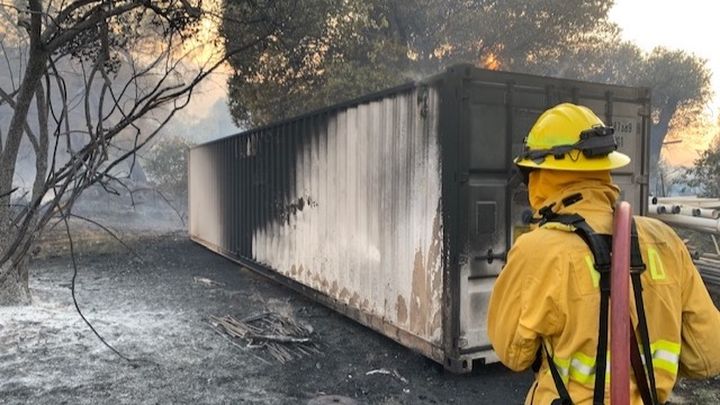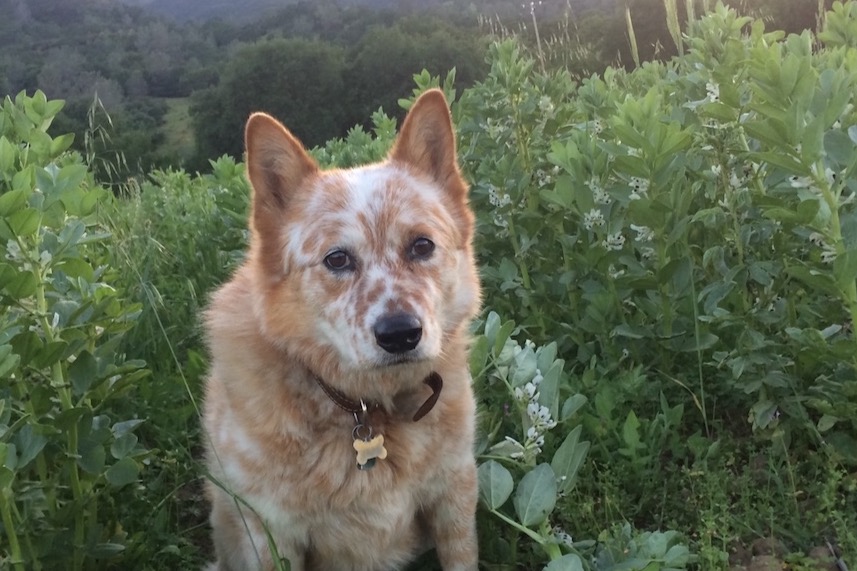
Capay Mills Wildfire Recovery

No one said farming would be easy.
I knew that when I stepped away from the convenience and comforts (and noise and traffic) of urban living in 2014 for the life of a would-be miller and grain grower in Capay Valley. The past five years have been a humbling lesson in human vs. nature, offering a first-hand education in drought, flood, wind and searing heat. I felt like I was learning something (humility, for example). After several years of wrestling with Mother Nature, I imagined I was getting acclimated to the struggle, and at least knew what to expect each season.
Then came 2019.
Record-breaking rain this winter not only made it impossible to finish planting my fields, but left the wheat that managed to germinate stunted and gasping for oxygen. When the skies finally cleared the grain put on a spurt of growth, only to be sucker-punched by violent cloudbursts in May, long past when the rain has normally finished for the season. Optimistic as ever, I still hoped to salvage a couple of acres of wheat and rye planted around the house.
That’s when I got a text from my assistant Karen as I was winding down the market at Ferry Plaza in San Francisco. It was an unnaturally hot and windy Saturday, June 8. The first Red Flag Warning day of the year. Karen had heard there was a fire in Guinda, five miles down the valley from my house and fields in Rumsey (pop. 150).
Almost exactly 12 months earlier, the 2018 fire season also kicked off in Guinda. This felt like Groundhog Day. Since Guinda was well downwind of Rumsey, and there wasn’t much there left to burn, I wasn’t overly concerned.
That all changed two hours later as I was stuck in traffic trying to get home. My landlord Chet called to say "David, I think your house may be gone". The fire wasn't in Guinda at all, but was a wall of smoke and flaming embers driven down the Arbuckle Grade by near gale-force winds, heading straight for my house and the dry grain fields around it.
By the time I got home an hour later, my first emotion was immense relief to see my house still standing, apparently untouched. Likewise, my pickup and VW camper were unscathed, along with other equipment in the yard that was barely damaged. My second emotion was gratitude for the firefighters spread out across the hillside, fighting in terrible conditions to direct the flames away from our town.
Then I saw that not everything had escaped destruction. My tractor, mower and forklift were still smoldering, tires in flames. Nothing was left in the shed where the forklift was parked, and a scorched a 40’ shipping container housing my tools, toys, and household posessions had smoke pouring out of it. A CalFire crew was hosing down still-flaming patches in the yard. That evening it was hard to tell what had survived in the post-apocalyptic landscape. 
When the embers cooled on Sunday, I totaled up the damage. While the tractor, mower and forklift were clearly in Valhalla, I was relieved to find that between puddles of melted plastic and a thick glaze of toxic creosote much of the shipping container's contents were still recognizable. Miraculously, other than melted tires and plastic tarps covering equipment, much of the farming equipment elsewhere in the yard escaped serious damage.
My field of rye and Italian heirloom varieties survived unscathed. But the Sonora next to it, at least whatever was left standing after the last rains, was fully flattened by fire crews putting out burning embers that fell on the dry grain. Fortunately it was just a small field, but it makes me sad to have lost the valuable seed and effort gone into planting it. 
I feel immensely fortunate not to have lost more to the fire. Even so, when I added up how much it will cost to replace the equipment and materials that are clearly lost, it comes to over $15,000. Of that, renter's insurance only covers $2500 of 'business equipment'. I think I'll have a hard time arguing that the forklift (not to mention the tractor) were 'recreational vehicles' rather than 'business equipment'.
Here are approximate costs to replace farming equipment and materials lost in the fire:
John Deere 4020 tractor (well used, but it had new tires and hydraulics!): $5000
Clark CFY 20B forklift (equally 'experienced"): $2500
6' deck mower: $650 (I'd like to replace with a heavier duty used flail mower, which will cost $2-3000)
40' rented storage container: $5500 (what the rental company is demanding as replacement cost... though they only cost $3000)
40' Portable shelter cover: $1500
30' Portable shelter (garage): $1200
Replacement tires for grain drill, auger and equipment trailer: $275
Power and hand tools, hardware, spare parts: $1500
It's now been three Saturday's since the fire. I’ve barely been able to keep up with a surge of orders for flour, much less harvest the fifteen or so acres of heirloom wheat that survived both deluge and fire. I haven’t had time (or the protective gear) to unload the container and get a detailed inventory of what is salvageable.
Meanwhile, I will start harvesting wheat this week, and need to mow, till and plant a cover crop as soon as possible after that in anticipation of fall planting. I know I can borrow neighbors' equipment that I might need, but I'm at markets on the weekends when any equipment is available. In other words, shopping for a used tractor and forklift is the last thing I have time for at the moment... but need to start the process. 
No one said farming would be easy... but this year has been a little ridiculous.
It’s a tough business, unsympathetic towards tyros like me, and unmoved by catastrophes like fire or the floods affecting the Midwest. Big farms can turn to the USDA and FSA for help, but not much support is available for tiddlers like Capay Mills where farming is in support of milling, and not my primary business.
I'm reaching out to you my customers, friends and colleagues for your help to replace the equipment and materials lost in the fire so I can harvest, prepare and plant my fields in the coming weeks.
You're already partners in this journey. By baking with fresh, wholesome, locally grown flour, subscribing to my newsletter, listening to my impromptu lectures about Falling Numbers and the evil of refined flours, by showing up at Ferry Plaza, Temescal and Davis Farmers' Markets rain or shine to buy grains and flour, you're the most crucial partners for building a thriving market for local grains and flours. Now that you've bought the fruits of my efforts and those of the farmers I work with, you have an opportunity to help purchase the means of production themselves- the tractor, the mower, the forklift and the equipment needed to bring grain from the field to your family's table.
While financial assistance (donations or loans) is what I need most, I'm grateful for whatever help you can offer: financial, material or intellectual. I can use a hand with everything from packaging redesign and printing to a mower to knock down the weeds around my house. I can use help harvesting some 10-15 acres of wheat in the coming days. It would be great to find a knowledgeable and enthusiastic baker to sell flour and educate customers at my farmers’ markets in SF and/or Oakland several days a month, freeing me to work my fields and raise investment for growth. 
Max and I give you our heartfelt thanks and deep appreciation for your contribution, and for your commitment to building resilient, equitable, transparent food systems that nurture the soil, our bodies, our communities and our souls. (With apologies to Max for gratuitous use of his furry image...)


